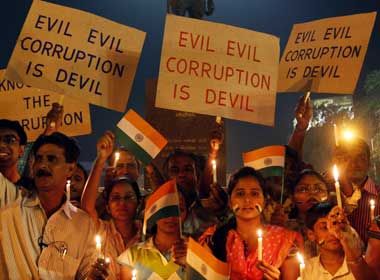Here’s a wake-up call for anyone who thinks people have great faith in our netas and babus: A CNN-IBN State of the Nation Survey spanning 1,300 locations all over India suggests that elected representatives and government employees are the most corrupt elements in society. Some 43 percent of the respondents put the former on top, which 32 percent voted for the latter. But here’s the paradox: since corruption needs both a bribe giver and a taker, and assuming politicians and bureaucrats are mostly in the receiving category, the surprise is the low level of people (just 3 percent) who think businessmen (the bribe givers in most cases) are corrupt (See Table 2 below) The only way this paradox can be explained is by extrapolating what corruption actually means to the aam aadmi in terms of everyday corruption. And this he sees plenty of. [caption id=“attachment_57619” align=“alignleft” width=“380” caption=“Is recency a factor when it comes to the overall, clearly anti-government sentiment we see through the poll? Amit Dave/Reuters”]  [/caption] Uniformly — across the urban and rural categories, and among both rich and poor — the policeman is seen as the most corrupt, with his corruption ratings varying from 19 percent for the rural poor to a high 42 percent for the urban rich. Not surprising, since not much money can be made from the rural poor, while the urban rich are cash cows for the men in uniform. The big villains for the rural poor (and the rich) are the panchayats and tehsil offices — with 24 percent and 18 percent rating them as most corrupt — says the survey, conducted by the Centre for the Study of Developing Societies in 19 states. (See Table 1 below). Given this daily reality of corruption in the aam aadmi’s life, it is no surprise that businessmen, the judiciary and the media are seen as almost blameless in matters of graft and corruption. Only 3 percent of the rural poor believe that the ration shop, the face that matters to them in the public distribution system, is the most corrupt place they need to visit – while 12 percent of their urban counterparts feel so. Surprisingly, given inadequate public health facilities, only 3 percent of the rural poor seem to think of hospitals as dens of corruption, while 6 percent of the urban poor agree. Pointers, perhaps, to governments, that they should be looking harder at the needs and worries of a growing urban poor? The media is clearly seen as a friend in the battle against corruption, with only 2 percent seeing the fourth estate as the most corrupt. Public perception is that the judiciary is far less corrupt than the media, with only 8 percent overall believing that the court is the most corrupt place they visit. The judiciary is seen by only 4 percent as the most corrupt class of people they have to deal with. Is recency a factor when it comes to the overall, clearly anti-government sentiment we see through the poll? Headlines in both print and TV, during the last year, have been dominated by the wrongdoings of politicians. Even in the 2G case, for example, it’s the politicians, the corrupted, who capture the imagination of journalists and headline writers. News which refers to the shenanigans of others gets relegated to single-column stories on the inside pages. If these are the headlines that matter to viewers and readers, these are the headlines that will continue to dominate. The only thing that politicians can do to change the pecking order is to change the way they run governments –and that’s no easy task. Table 1: The most corrupt institution/office [caption id=“attachment_57524” align=“alignleft” width=“550” caption=“Police station most corrupt”]  [/caption] Table 2: Which group is most corrupt [caption id=“attachment_57545” align=“alignleft” width=“323” caption=“Legislators are the most corrupt.”]  [/caption] CNN-IBN CNBC-TV18 State of the Nation Poll in association with Forbes India conducted by CSDS
And it is no surprise that businessmen, the judiciary and the media are seen as almost blameless in matters of graft and corruption.
Advertisement
End of Article


)
)
)
)
)
)
)
)
)



